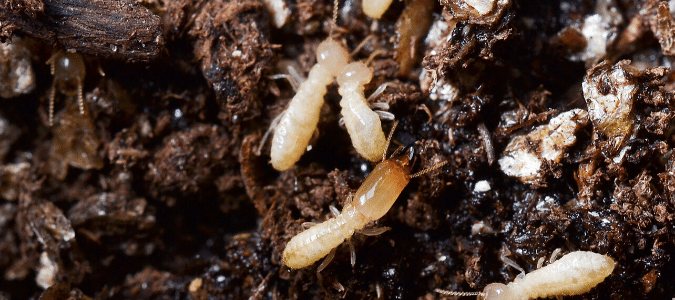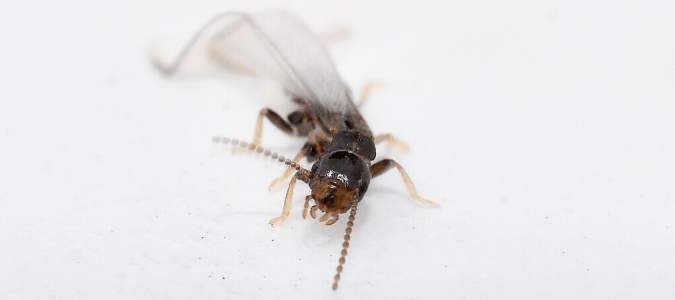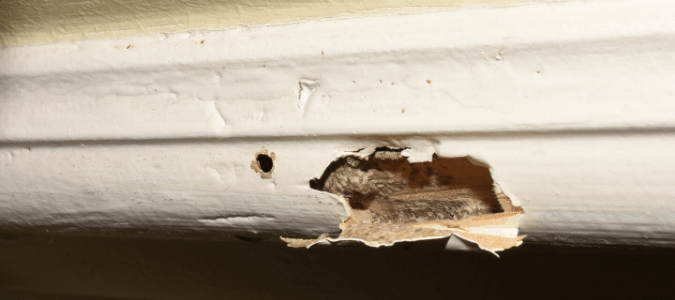No one wants to see something odd going on with the wood in their homes. Whether it’s a door or window, any kind of damage can send a homeowner into a panic. What if the wood has rotted? Or what if termites have invaded and moved into the home? First, it’s important to know how to tell each type of damage apart from one another.
How to Tell If It Might Be Termites
There are a few tell-tale signs of termites. First, you might see termite swarmers lying dead on a window sill, around a door or flying around. Or you might see mud tubes going up from the ground to your foundation or along a wall in a crawl space. These are shelter tubes that do what they sound like they do. They shelter termites while they march into your home for a wood feast. The third obvious sign is wood damage in your home.
How do you know if wood damage is caused by termites? It’s important to first know how termites get into your house. These tiny creatures chew their way through floorboards, wall studs—really any wood in the home—and leave a maze-like trail or little grooves behind them. The problem is that once you see such markings, termites likely have been in your home for a very long time and already caused a good bit of damage. That’s why it is so important to have regular home maintenance checks done by a licensed professional. They can save you thousands of dollars and a lot of headache by catching any termite issue early.
Maybe It’s Wood Rot
Wood rot can also be quite damaging, but it has a look that is very distinctive from the damage caused by termites. Wood rot happens when the wood gets and stays damp. First, let’s look at where you typically find wood rot.
As you might expect, spots in and around your home that experience a lot of moisture or are exposed to the elements are wood rot hot spots. You’ll often find rot on window casings, especially in older windows where the caulking might not be completely sealed anymore. Exterior doors that are not protected by any sort of porch are also prime candidates for wood rot.
You can also find the rot on horizontal decking and wood stairs outside. Wet rooms inside, such as a bathroom, laundry room or kitchen, are at risk especially if you have a slow leak that you don’t catch for a while. Basements have the same issue. They are generally damp anyway, and if there is any kind of leaking, wood can rot for a long while before it’s caught. This can mean major structural damage to your home. If your roof has lost some shingles, rain will seep into the decking and the rot will start its spread.
Many of these issues go undetected until you are replacing a door or doing another renovation or repair. It is an unpleasant discovery to be sure! If you see any wood around your home that looks discolored, brittle, flaky or spongy, it’s a good sign you have wood rot. The water that has sat on wood creates the perfect environment for fungi to grow, and there is no going back from that. You will have to have the affected area restored.
Homeowners can check around their homes for spongy wood spots that are soft when you press with something like a screwdriver. But, if you’re unsure whether you’re dealing with termites or wood rot, a better choice would be to contact a licensed professional. Then, if termites are spotted, your professional can come up with a pest treatment plan.
Termite Lifespan
If you do find termites in your home, that means you have an active infestation. Since it takes termites a long time to create an active colony, it’s helpful to know the life cycle of termites:
- Winged termites leave an active colony, pair up, find a place to call home and shed their wings.
- They begin to create their own little termite family, with the two founding swarmers becoming the king and queen.
- The eggs laid by the queen hatch into pale white larvae, then hatch again.
- These larvae molt to develop into either workers, soldiers or primary or secondary reproductives. Each has a separate job and varies in color.
Workers build tunnels and chambers and feed and groom the other termites. Soldiers are a yellow-brown color and have larger heads than other varieties. The reproductives are darker and have two pairs of wings. Workers and soldiers live about one to two years, but queens may live for over 10 years if conditions are right.
How to Treat Termites
There are a few things homeowners can do to help prevent an infestation. First, keep the soil around your foundation dry and make sure it has adequate grading and drainage. Also look for cracks in your foundation or the places where utilities go through walls and seal all openings. If you have a water leak in the home, don’t wait. Fix it right away.
Outside, make sure your vents aren’t blocked by anything, even plants. Don’t let your trees and shrubs grow against exposed wood in your home. That gives termites a direct path! If you have a wood-burning stove or fire pit, resist the temptation to stack firewood next to your house. That’s very tempting for termites! And finally, look around your home, inside and out, for signs of termites. The best prevention for an infestation is to call in a licensed pest professional annually for a thorough inspection.
Building a physical barrier to entry can keep termites at bay as well. If you have a new build, ask about installing a barrier during construction. Adding steel mesh and certain types of sand can also block the termites. Some biological control agents have also had success in treatment.
Certain chemical treatments that have met the standards set by the Environmental Protection Agency are also very effective. The types include liquid chemicals that go on your lawn, baits and certain wood treatments. Contact a licensed pest control professional who can help you determine which termite treatment is right for your situation and make sure to take care of the problem fully.
ABC Can Treat and Prevent Termites
Termites can cause expensive damage to your home. If you think you may have termites on your property, contact ABC Home & Commercial Services. Our pros use scientifically proven methods to eliminate these pests. We even provide termite control for new construction!



